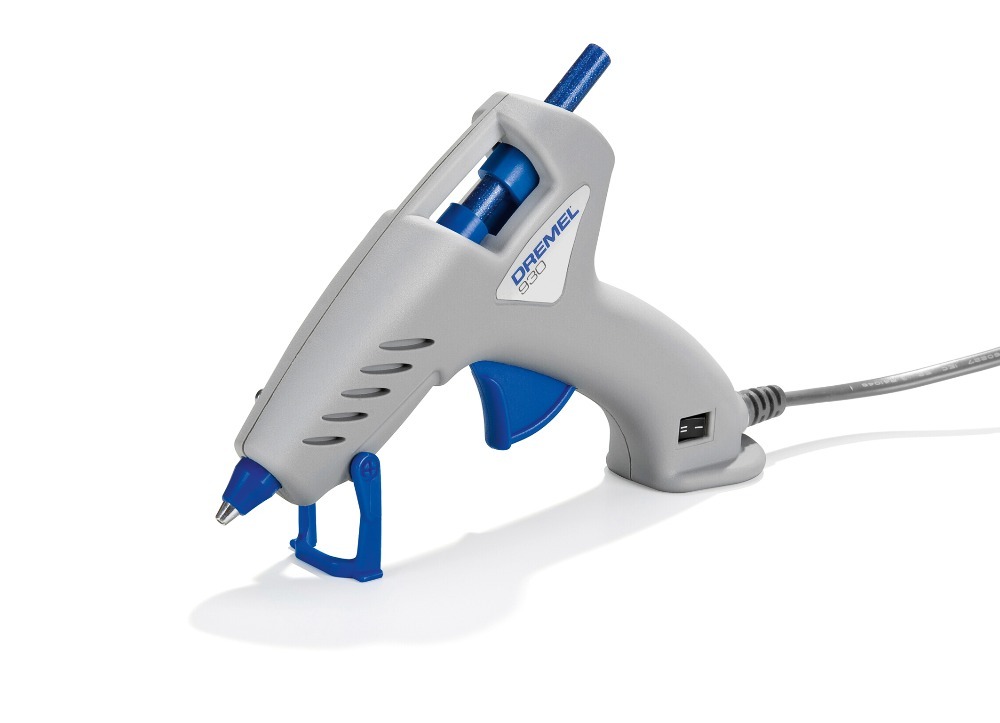Do you want to make heating in the bathroom? Can't decide which option is best? Interested in underfloor heating, convectors, infrared heaters or other ways to heat your bathroom? Then read on - why you need heating in the bathroom, types of bathroom heating, the advantages of different types of heating, how to independently equip heating in the bathroom of a private house.
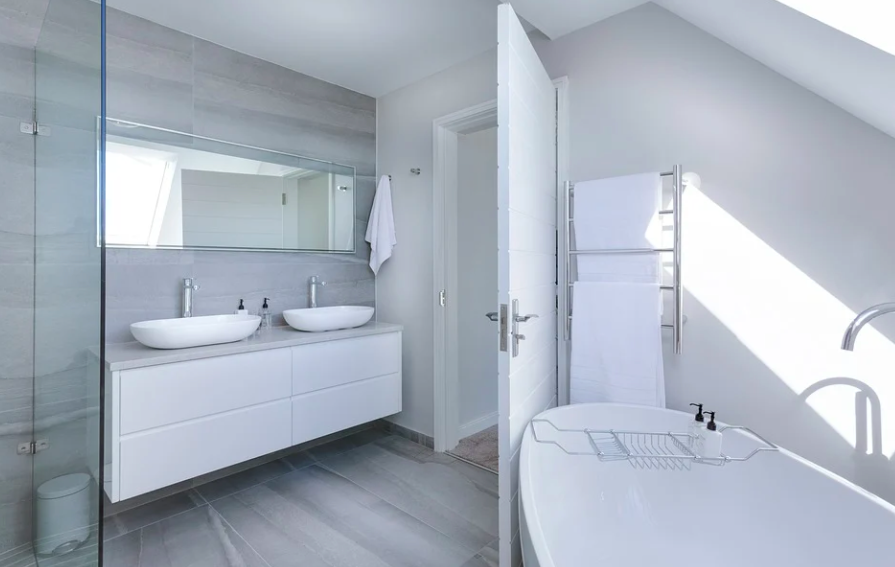
The content of the article
- Why do you need heating in the bathroom
- Batteries, radiators and convectors
- Towel dryers
- Infrared bathroom heaters
- Underfloor heating for the bathroom
- warm ceiling
- Air conditioning in the bathroom
Why do you need heating in the bathroom
If you want to make heating in the bathroom, then most likely you know why. But just in case, let's explain:
The bathroom is usually the wettest room in a room, whether it's a house or an apartment. A large amount of moisture that does not dry out and does not evaporate from the room will lead to mold and mildew in the corners, on the walls, and on the handles of the room. Also, the problem of heating is relevant in winter - in order not to get out of the shower, cringing from the cold, the bathroom should be heated.
That is, heating in the bathroom is necessary to dry and evaporate moisture, due to which mold and fungus can form, and to create comfortable conditions in the room in winter.
Heating the bathroom helps in the fight against fungus, mold and other growths in winter. In the summer, when heating is not used, excess moisture is vented from the room. For this, ventilation is installed in the bathroom. Ventilation may not be the usual mine with a grate and a fan going outside. A simple window or even an air conditioner can be considered ventilation in the summer. Yes, air conditioning. In the last 5-6 years, there has been a trend towards installing air conditioners in the bathroom. This is explained by their convenience - air conditioners (usually install split systems) can ventilate and heat the air. In this case, they act as a ventilation system and as heating equipment in winter. What about security? After all, electrical equipment in the most humid room does not sound very safe. There are moisture resistant models - they can be used in the bathroom. They won't break or cause a short circuit. If the model is moisture resistant, the manufacturer writes this on the packaging and in the instructions.
Types of heating for the bathroom, their advantages and disadvantages, how to independently make heating in the bathroom.
In total, there are 6 ways to heat the bathroom:
- Batteries, radiators and convectors
- Towel dryers
- Infrared heaters
- Warm floor
- warm ceiling
- Air conditioner
Below we will analyze in detail each of the types, their pros, cons, features.
Batteries, radiators and convectors
Batteries, radiators and convectors are the standard way of heating. They are hung, as a rule, on the walls, but it is also possible on other planes - the floor, window sill or even the ceiling. Batteries, radiators and convectors can be electric and run from a socket or transfer heat from a central coolant. The heat carrier is usually water. Hot water can be supplied from the central network or from a private heating network.
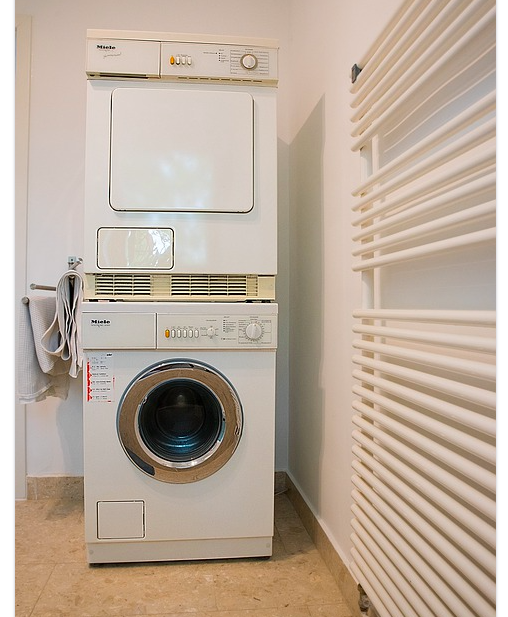
Non-electric radiators/batteries/convectors. In fact, these are several devices connected by pipes through which hot water is supplied. In them, the water gives off heat to the room. To make such a heating system, you need:
Apartment - apply to the relevant service, turn off the water supply, lay pipes through the radiator, legalize the installation.
House - stretch pipes, connect a radiator / battery or other device.
It seems that it is easier to do this in a private house, but there are some disadvantages. Firstly, in order to connect to the central heating system, you need to submit several documents, spend a lot of money, time and nerves. Secondly, if you equip a private heating system, then you need to order a boiler / stove, buy a barrel, insulate the barrel to reduce heat loss, connect the boiler to the barrel two pipes, which are also interconnected by one pipe and two pumps, install a chimney on the boiler, run two pipes from the barrel to the house, install pumps on them, in make a pipe system at home, install convectors / radiators, connect pipes to them, connect the entrance and exit with them, repeat the operation in each room, connect everything with the second pipe from the boiler, draw water into the system, drive it away to remove air from the pipes and radiators, bleed the remaining air from the radiators themselves, close and seal system.
Electric convectors, radiators. Electric models in terms of installation and operation are simpler - just install the models in the chosen place next to the outlet, plug them into the outlet, turn on the device. The disadvantage of electric convectors is the price and the price of their use, however, such models can be installed anywhere - a wall, floor, ceiling, and even a window sill.
Towel dryers
Brezhnevka houses do not provide heating for the bathroom. Instead of batteries, they installed one curved pipe as a heated towel rail. He also heated the bathroom. They decided to modernize this idea - a powerful electric heated towel rail can be installed in the bathrooms, which will both dry towels and heat the room. As you understand, the advantages of this method are versatility, fast heating, easy installation, no need for additional documents. Of the minuses - the price and the cost of use (the cost of electricity for heating in some areas is too high).
When choosing a heated towel rail for heating a room, pay attention to its power. For a comfortable temperature in the bathroom, the power of the device should be 100 watts per square meter of the room.
To install an electric towel warmer, choose a suitable location near a power outlet. Attach your device. Use a spirit level to level the instrument. Make marks in the mounting holes. Remove the heater. Drill holes in the marks for the mounting bolts. Insert the dowels from the kit. Attach a heated towel rail with washers, rubber bands, if any and they are provided for by the instructions. Insert and tighten the bolts. Plug the heated towel rail into the socket, check how the device heats up.
Infrared bathroom heaters
Not the most popular way to heat a bathroom. Most often they are installed in private homes. Infrared bathroom heaters are electric heating equipment with high moisture resistance. The principle of their operation does not differ from conventional infrared heaters - there is a heating element (carbon fiber, halogen, heating element, ceramics), a current is passed through it, from which it heats up. The generated heat falls on the reflector - a special plate / coating that reflects up to 97% of all heat received. The reflector directs and concentrates heat on one area/group of objects. A feature of infrared heaters in spot heating is that they do not heat the air, the reflected heat is absorbed only by objects in the room. Thus, objects in the room turn into secondary sources of heat - they give off heat to surrounding objects, people, air and the entire room. Due to the same feature, their heat heats only a certain area, while the other remains cold. Also, heat with spot heating cannot avoid obstacles - if you have a sofa in front of the heater, and a chair behind it, then the heater will heat the sofa, but the chair will remain cold.
Underfloor heating for the bathroom
Like radiators, batteries, convectors, a warm floor can be independent (electric) and water (a system of pipes with a hot coolant that transfers heat to the floor).
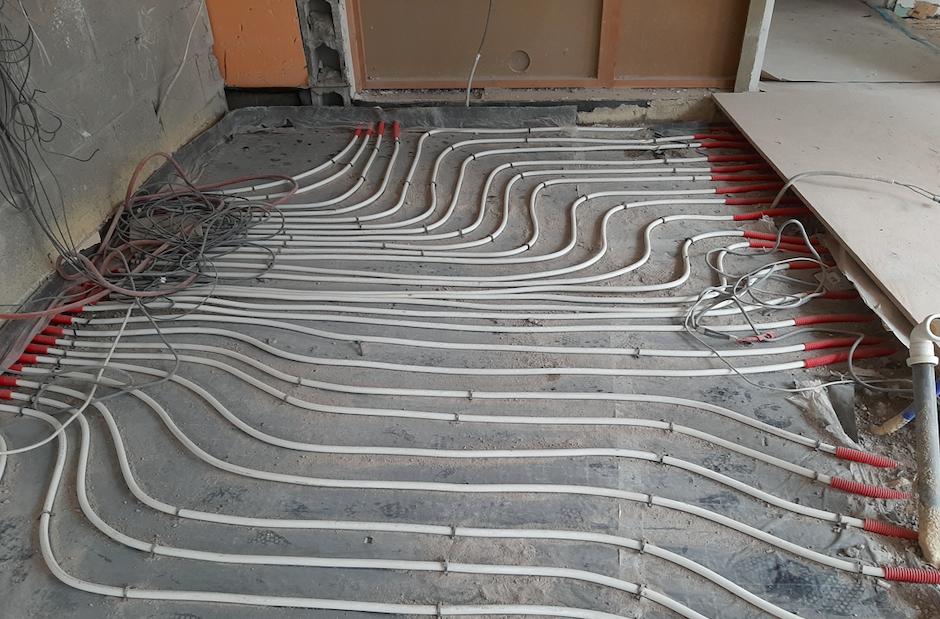
Electric underfloor heating happens:
- cable,
- film.
Cable electric floor heating - lay the cable on the prepared surface (insulation is covered on the concrete of the room, it is covered with foil to reduce heat loss). The cable itself consists of a heating element, a coolant (water or aqueous solution), two layers of insulation. A cartridge, wires or a plug are built into the heating element, which are connected to the temperature controller. The regulator itself is connected to the mains. The cable laid on the floor is covered with a 5-7 cm layer of concrete. Concrete is covered with laminate, boards, tiles or tiles. The electricity turns the heating element into a filament. It heats up the coolant. The heat carrier gives off heat to concrete and a covering. So it turns out a warm floor. The heat from it heats the air, which, rising, warms the entire room. Only the effectiveness of such heating will be small - a smaller part of the heat reaches the air, but the legs will be warmed. The floor will then rise by ±10 centimeters.
Film floor differs in base from cable - if in cable it is a special cable, then in film it is a thermal film with a set of plates. The plates are made of graphite heating elements. When current passes through them, they heat up. Two wires come out of the thermal film, which are connected to the regulator, the regulator to the outlet. Film electric floor heating consists of:
- Primary floor (pure concrete)
- Insulator (film)
- Reflective material/foil
- Thermal films
- protective film
- Coatings (laminate, carpet, linoleum)
The advantages of film models are ease of installation, higher heating temperatures and the fact that the floor does not rise so high (2-3 cm).
Pipe heated floor - a set of pipes with a heat carrier passing under the coating. In private houses outside the house or in the basement there is a barrel of water and a boiler. Fuel (firewood, gas, pellets, oil, diesel fuel) burns in the boiler, heating a portion of water. After reaching a certain temperature, circulation between the boiler and the barrel is started, all the water is heated. Hot water goes through pipes to the house, where it heats the room through a network of radiators / batteries and / or underfloor heating.
To equip this type of heating, lay an insulator on the primary floor. Next, lay down foil or another reflector. Make a pipe system along the entire surface of the floor. Between them there must be the same distance for high-quality heating. Install wooden support boards. Fill the surface with concrete with a layer of 5-7 centimeters - do not forget to leave outlets for pipes. Wait for the layer to dry completely, remove the wooden boards, cover the concrete with the prepared coating. Connect the pipe outlets to the laid system from the barrel. Supply water to the system to remove all air from the pipes.
The advantages of this method: it is cheap, no additional documents are required, it warms up efficiently. Cons: difficult installation, compared to other options, the floor will rise by 10-12 centimeters, warms up the room for a long time.
warm ceiling
This is probably the most unusual way to heat a bathroom, but it must be mentioned. Users install thermal film on the primary ceiling. Usually use self-tapping screws with dowels or construction staplers. Under the film they like to install a false ceiling. The thermofilm is connected to the regulator, that to the socket. Electricity heats up the elements in the film. The air receives heat from them and stays upstairs, slowly filling the room from top to bottom. A warm ceiling is not popular either in the CIS or in Western countries. This is explained by its low efficiency and the difficulty of installation. The top of the room is heated while the feet remain cold.
Air conditioning in the bathroom
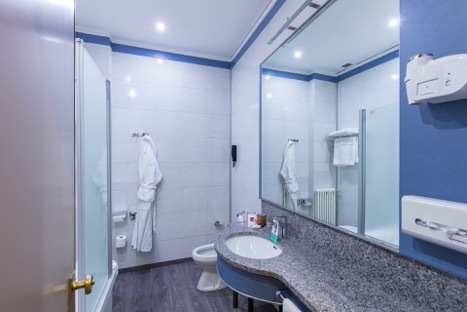
Another nonsense - air conditioning in the bathroom. Usually they try to equip the bathroom with as little electrical equipment as possible, or at least with moisture protection, for obvious reasons. And therefore, putting air conditioning in the bathroom will seem like nonsense to many, although this has its advantages. It was already mentioned above that the air conditioner (split system) is multifunctional: in summer it can be used to ventilate the bathroom, in winter for heating / air heating. Air conditioning is installed in large bathrooms, where there are no windows. Through holes are made outside the house and brackets are placed for fastening the street block. Tubes are passed through the walls, and wiring is also carried out to this place to power the device. Install the indoor unit of the split system. Connect all pipes and wires to it.
When choosing a bathroom air conditioner, make sure the model is IP24 or higher.
